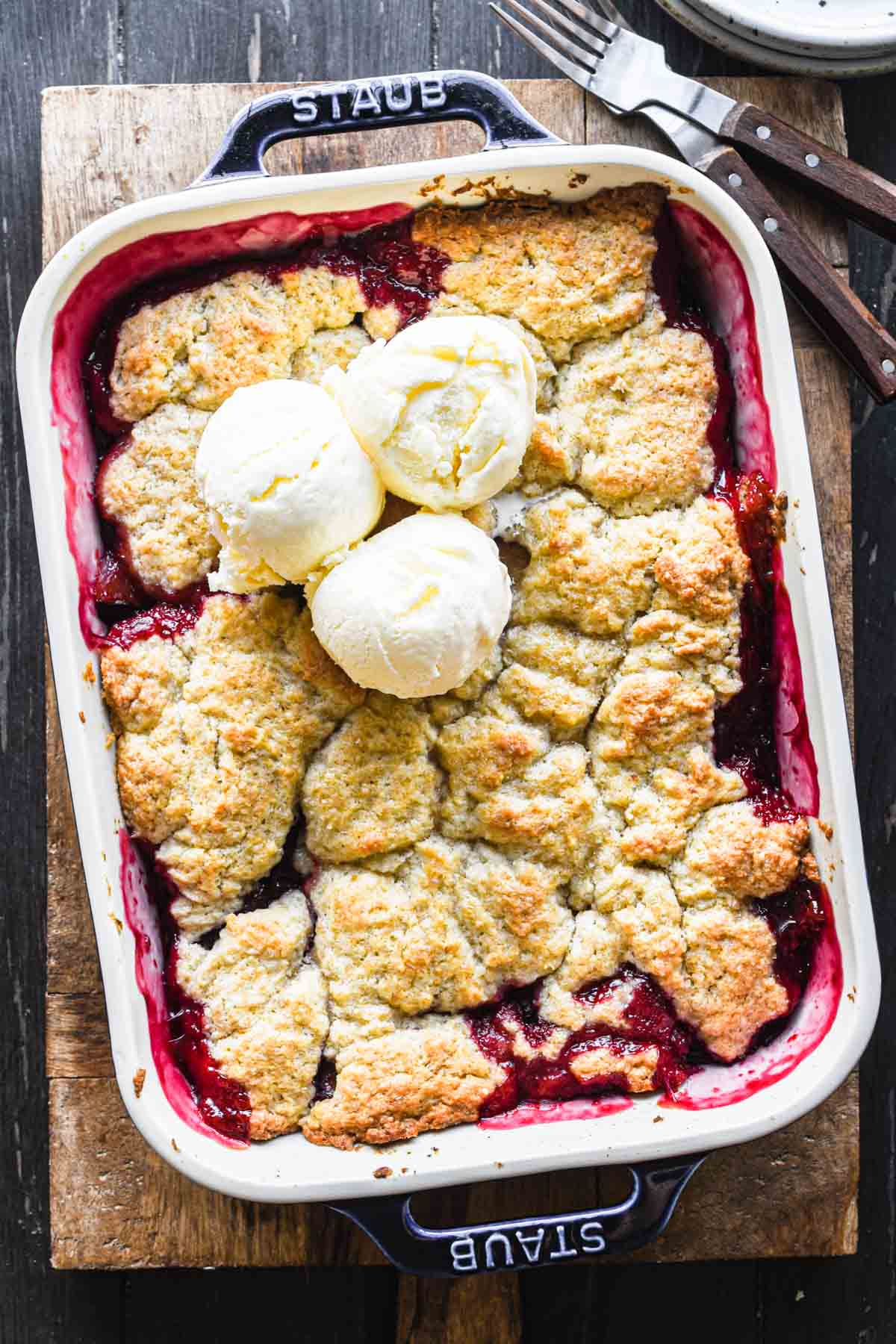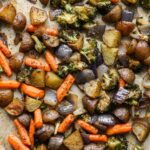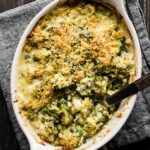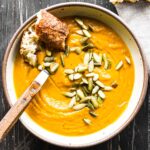This classic Easy Plum Cobbler is the epitome of summer. Fresh, juicy plums are mixed with sugar and a bit of lemon zest, then topped with a tender, almost biscuit-like topping with a hint of cardamom. It’s absolutely delicious, and a wonderful summer dessert.

Jump to:
Ingredients
Listed below are the ingredients needed for this fresh plum cobbler recipe, and a bit about each of them. You should be able to find all of these in your local store if you don’t have them in your pantry already.

- Plums: Sweet plums, best in the summer. Any variety works here - the most common you’ll find in the store are red plums and black plums. In terms of ripeness, you’re looking for a slightly firm plum that still has a little give when gently squeezed.
- Granulated sugar: Classic white sugar gets mixed with the plums as well as in the batter for the cobbler topping.
- Corn starch: This recipe uses corn starch in the plum mixture to thicken the juices that the plums will inevitably release, which ultimately gives you a delicious thick saucy plum mixture.
- Lemon zest: Zest gets added into the plum mixture to add some brightness and acidity.
- All purpose flour: Standard baking flour – the base of the cobbler topping.
- Baking powder: This is the leavener for the cobbler topping. Unlike baking soda, baking powder has an acid and a neutralizer within it, so does not need acid to be present elsewhere in the recipe (such as buttermilk). Whereas baking soda needs an acid in the recipe to react with. So in this recipe’s instance, there is no presence of a dominant acid because we use whole milk, so baking powder should be used.
- Butter: Cold, unsalted butter helps make the biscuit topping tender, flavorful, and flaky.
- Whole milk: Regular milk is used to bring the topping for the cobbler together into a soft dough (slightly thinner than a biscuit-like texture).
- You can use 2% milk, coconut milk, almond milk, etc.
- Cardamom: One of my absolute favorite spices to bake with – it has a warm yet citrusy flavor that is SO good.
- Raw sugar: Adding a little sugar on top of the dough before baking gives it a crispy, shiny crust.
- Salt: Kosher salt. Always. Added to the plum mixture and the cobbler topping.
Step by step instructions
A cobbler is typically a relatively easy dessert, and this one is no different. Check out how to make it below:

1. Make the fruit mixture. In a medium bowl, toss together sliced plums, lemon zest, corn starch, salt, and sugar. Transfer to the baking dish / casserole dish.

2. Start on the dough. Mix together the flour, remaining sugar, baking powder, salt, and cardamom.

3. Mix in the butter. Cube your cold butter. Work it into the dough with your hands in a pinch and mix motion until you have some small pieces (pebble-sized) and a few larger, incorporated with the dough.

4. Add the milk. Pour the milk into the flour mixture and use a wooden spoon to mix together until a wet dough forms.

5. Add the cobbler topping. Spoon dollops of dough on top of the plums in the baking dish. Then sprinkle it with raw sugar.

6. Bake! Bake until the fruit is bubbling around the edges and the biscuit topping is golden brown.
Tips and tricks
Summer fruit cobblers are truly the best – some tips and tricks below to help make sure you crush it.
- Types of plums: There are hundreds of plum varieties in the US, but you're likely to only find a handful in your grocery store. What you’re most likely to find are plums categorized simply as red and black, but more specifically – specifically satsuma (reddish and yellowish skin and red flesh), santa rosa (vibrant red on the outside and inside), and black ruby (dark black/purple skin with a yellow flesh).
- Plum trees can thrive in your yard so if you're able to, try planting ont!
- How to slice a plum: The easiest way to slice a plum is to insert your knife into it until you hit the pit, then slice around the pit. Twist the plum open into two halves, remove the pit, then slice into wedges.
- Types of raw coarse sugar: Raw sugar is most commonly in grocery stores as Sugar In The Raw or raw turbinado sugar. This is essentially brown sugar that is more coarse and less processed.
- How to cut in butter:
- With your hands: use a squeeze/pinch/snap motion in your hands to squeeze the butter with the flour until you get coarse crumbs (pea/pebble sized) of butter and the flour is hydrated.
- With a pastry blender/pastry cutter: push the cutter into the butter and twist into the flour.
- With knives: use two knives and cut with your hands moving in opposite directions.
- I prefer to use a 9x7" baking dish for this recipe so there is a good layer of plums. But you can use a bigger size it'll just yield a thinner plum layer.
- If you need to speed up ripening plums put them in a brown paper bag for one to two days.
- You could also add some vanilla extract or vanilla bean paste to the plum mixture, but I don't think it needs it.
How to serve
While it’s nearly mandatory that cobbler is served warm with a scoop of ice cream (à la mode), it’s also delicious when served with some homemade whipped cream (or coconut cream) or whipped yogurt,
Storage and reheating
This cobbler can be stored in the fridge covered for up to two days. It’ll get a bit soggy while it’s in there, but if you eat it within two days it’s still great.
To reheat, just quickly warm in the microwave.

FAQs
Plums are actually rather low in sugar compared to some other fruits (for example: 1 cup has 16g of sugar, whereas 1 cup of grapes has 23g of sugar), and they have a low glycemic index. More on this here.
Yes! Plums can be frozen for up to 6 months. Simply slice them in half and remove the pit, then store in a freezer safe bag or container. For this recipe in particular, you’ll want to defrost them in the fridge overnight and then strain out any excess liquid.
No, they don’t! They have a very thin skin that breaks down plenty when baked.
It’s actually preferred that they’re a little bit under-ripe so they don’t break apart too much, but if they’re fully ripe that’s perfectly fine!
Yes! It has a pit (“stone”) in the center, so it is in the stone fruit family. Other stone fruits are nectarines, peaches, cherries, and apricots.
Between late June and early September.
Yes! I'd recommend sticking in the stone fruit category though as the measurements are perfect for it. But even if not, berries would be great too.
More plum recipes
📖 Recipe

Easy Plum Cobbler
Ingredients
For the fruit:
- 6 cups sliced plums 8-12 plums depending on their size
- ¼ cup granulated sugar
- 1 tablespoon corn starch
- 1 teaspoon lemon zest
- ¼ teaspoon kosher salt
For the cobbler topping:
- 1 ½ all purpose flour
- ½ cup granulated sugar
- 1 ½ teaspoon baking powder
- ½ teaspoon cardamom
- ½ teaspoon kosher salt
- 1 stick cold unsalted butter cubed
- ½ cup whole milk
- 1 tablespoon raw sugar
Instructions
- Preheat your oven to 375℉ and get a 9x7" baking dish.
- In a medium bowl, toss together sliced plums, lemon zest, corn starch, salt, and sugar. Transfer to the baking dish / casserole dish.
- In a large bowl, mix together the flour, remaining sugar, baking powder, salt, and cardamom.
- Cube your cold butter. Work it into the dough with your hands in a pinch and mix motion until you have some small pieces (pebble-sized) and a few larger, incorporated with the dough.
- Pour the milk into the flour mixture and use a wooden spoon to mix together until a wet dough forms.
- Spoon dollops of dough on top of the plums in the baking dish. Then sprinkle it with raw sugar.
- Bake 40-45 minutes until the fruit is bubbling around the edges and the biscuit topping is golden brown.






















Leave a Reply